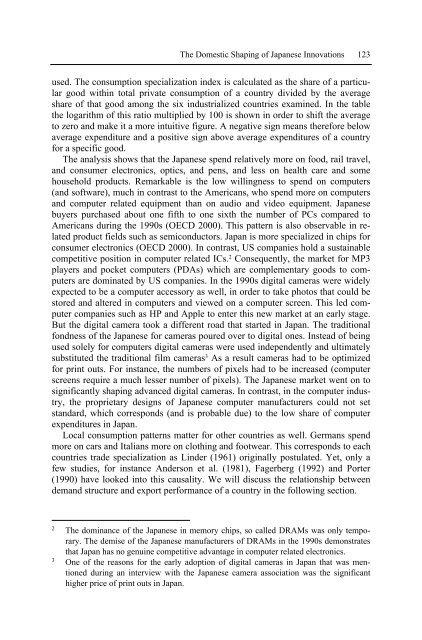Management of Technology and Innovation in Japan
Management of Technology and Innovation in Japan
Management of Technology and Innovation in Japan
You also want an ePaper? Increase the reach of your titles
YUMPU automatically turns print PDFs into web optimized ePapers that Google loves.
The Domestic Shap<strong>in</strong>g <strong>of</strong> <strong>Japan</strong>ese <strong>Innovation</strong>s 123<br />
used. The consumption specialization <strong>in</strong>dex is calculated as the share <strong>of</strong> a particular<br />
good with<strong>in</strong> total private consumption <strong>of</strong> a country divided by the average<br />
share <strong>of</strong> that good among the six <strong>in</strong>dustrialized countries exam<strong>in</strong>ed. In the table<br />
the logarithm <strong>of</strong> this ratio multiplied by 100 is shown <strong>in</strong> order to shift the average<br />
to zero <strong>and</strong> make it a more <strong>in</strong>tuitive figure. A negative sign means therefore below<br />
average expenditure <strong>and</strong> a positive sign above average expenditures <strong>of</strong> a country<br />
for a specific good.<br />
The analysis shows that the <strong>Japan</strong>ese spend relatively more on food, rail travel,<br />
<strong>and</strong> consumer electronics, optics, <strong>and</strong> pens, <strong>and</strong> less on health care <strong>and</strong> some<br />
household products. Remarkable is the low will<strong>in</strong>gness to spend on computers<br />
(<strong>and</strong> s<strong>of</strong>tware), much <strong>in</strong> contrast to the Americans, who spend more on computers<br />
<strong>and</strong> computer related equipment than on audio <strong>and</strong> video equipment. <strong>Japan</strong>ese<br />
buyers purchased about one fifth to one sixth the number <strong>of</strong> PCs compared to<br />
Americans dur<strong>in</strong>g the 1990s (OECD 2000). This pattern is also observable <strong>in</strong> related<br />
product fields such as semiconductors. <strong>Japan</strong> is more specialized <strong>in</strong> chips for<br />
consumer electronics (OECD 2000). In contrast, US companies hold a susta<strong>in</strong>able<br />
competitive position <strong>in</strong> computer related ICs. 2 Consequently, the market for MP3<br />
players <strong>and</strong> pocket computers (PDAs) which are complementary goods to computers<br />
are dom<strong>in</strong>ated by US companies. In the 1990s digital cameras were widely<br />
expected to be a computer accessory as well, <strong>in</strong> order to take photos that could be<br />
stored <strong>and</strong> altered <strong>in</strong> computers <strong>and</strong> viewed on a computer screen. This led computer<br />
companies such as HP <strong>and</strong> Apple to enter this new market at an early stage.<br />
But the digital camera took a different road that started <strong>in</strong> <strong>Japan</strong>. The traditional<br />
fondness <strong>of</strong> the <strong>Japan</strong>ese for cameras poured over to digital ones. Instead <strong>of</strong> be<strong>in</strong>g<br />
used solely for computers digital cameras were used <strong>in</strong>dependently <strong>and</strong> ultimately<br />
substituted the traditional film cameras 3 As a result cameras had to be optimized<br />
for pr<strong>in</strong>t outs. For <strong>in</strong>stance, the numbers <strong>of</strong> pixels had to be <strong>in</strong>creased (computer<br />
screens require a much lesser number <strong>of</strong> pixels). The <strong>Japan</strong>ese market went on to<br />
significantly shap<strong>in</strong>g advanced digital cameras. In contrast, <strong>in</strong> the computer <strong>in</strong>dustry,<br />
the proprietary designs <strong>of</strong> <strong>Japan</strong>ese computer manufacturers could not set<br />
st<strong>and</strong>ard, which corresponds (<strong>and</strong> is probable due) to the low share <strong>of</strong> computer<br />
expenditures <strong>in</strong> <strong>Japan</strong>.<br />
Local consumption patterns matter for other countries as well. Germans spend<br />
more on cars <strong>and</strong> Italians more on cloth<strong>in</strong>g <strong>and</strong> footwear. This corresponds to each<br />
countries trade specialization as L<strong>in</strong>der (1961) orig<strong>in</strong>ally postulated. Yet, only a<br />
few studies, for <strong>in</strong>stance Anderson et al. (1981), Fagerberg (1992) <strong>and</strong> Porter<br />
(1990) have looked <strong>in</strong>to this causality. We will discuss the relationship between<br />
dem<strong>and</strong> structure <strong>and</strong> export performance <strong>of</strong> a country <strong>in</strong> the follow<strong>in</strong>g section.<br />
2 The dom<strong>in</strong>ance <strong>of</strong> the <strong>Japan</strong>ese <strong>in</strong> memory chips, so called DRAMs was only temporary.<br />
The demise <strong>of</strong> the <strong>Japan</strong>ese manufacturers <strong>of</strong> DRAMs <strong>in</strong> the 1990s demonstrates<br />
that <strong>Japan</strong> has no genu<strong>in</strong>e competitive advantage <strong>in</strong> computer related electronics.<br />
3 One <strong>of</strong> the reasons for the early adoption <strong>of</strong> digital cameras <strong>in</strong> <strong>Japan</strong> that was mentioned<br />
dur<strong>in</strong>g an <strong>in</strong>terview with the <strong>Japan</strong>ese camera association was the significant<br />
higher price <strong>of</strong> pr<strong>in</strong>t outs <strong>in</strong> <strong>Japan</strong>.


